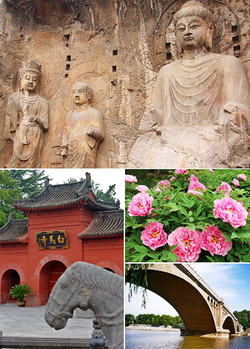Luoyi
|
Luoyang 洛阳市 |
|
|---|---|
| Prefecture-level city | |

Top: Longmen Grottoes, Bottom left: White Horse Temple, Bottom right: Paeonia suffruticosa in Luoyang and Longmen Bridge
|
|
 Luoyang in Henan |
|
| Location in China | |
| Coordinates: 34°40′11″N 112°26′32″E / 34.66972°N 112.44222°ECoordinates: 34°40′11″N 112°26′32″E / 34.66972°N 112.44222°E | |
| Country | People's Republic of China |
| Province | Henan |
| Government | |
| • Party Secretary | Li Ya |
| • Mayor | Bao Changyong |
| Area | |
| • Prefecture-level city | 15,229.15 km2 (5,880.01 sq mi) |
| • Urban | 810.4 km2 (312.9 sq mi) |
| • Metro | 733.7 km2 (283.3 sq mi) |
| Elevation | 144 m (472 ft) |
| Population (2010 census) | |
| • Prefecture-level city | 6,549,941 |
| • Density | 430/km2 (1,100/sq mi) |
| • Urban | 1,926,079 |
| • Urban density | 2,400/km2 (6,200/sq mi) |
| • Metro | 1,857,003 |
| Time zone | China Standard (UTC+8) |
| Area code(s) | 379 |
| GDP | ¥52541 per capita (2015) |
| Ethnicities | Han, Hui, Manchu, Mongolian |
| County-level divisions | 15 |
| Township-level divisions | — |
| License plate prefixes | C |
| Website | www |
| Luoyang | |||||||||||||||||||||||||

"Luoyang" in Simplified (top) and Traditional (bottom) Chinese characters
|
|||||||||||||||||||||||||
| Simplified Chinese | 洛阳 | ||||||||||||||||||||||||
|---|---|---|---|---|---|---|---|---|---|---|---|---|---|---|---|---|---|---|---|---|---|---|---|---|---|
| Traditional Chinese | 洛陽 | ||||||||||||||||||||||||
| Literal meaning | "Northern bank of the Luo [River]" | ||||||||||||||||||||||||
|
|||||||||||||||||||||||||
| Transcriptions | |
|---|---|
| Standard Mandarin | |
| Hanyu Pinyin | Luòyáng |
| Gwoyeu Romatzyh | Luohyang |
| Wade–Giles | Lo4-yang2 |
| IPA | [lwô.jǎŋ] |
| Yue: Cantonese | |
| Yale Romanization | Lohk-yèuhng |
| IPA | [lɔ̀ːk̚.jœ̏ːŋ] |
| Jyutping | Lok6-joeng4 |
| Southern Min | |
| Tâi-lô | Lo̍k-iông |
Luoyang, formerly romanized as Loyang, is a city located in the confluence area of Luo River and Yellow River in Central China. It is a prefecture-level city in western Henan province. It borders the provincial capital of Zhengzhou to the east, Pingdingshan to the southeast, Nanyang to the south, Sanmenxia to the west, Jiyuan to the north, and Jiaozuo to the northeast. As of the final 2010 census, Luoyang had a population of 6,549,941 inhabitants with 1,857,003 people living in the built-up (or metro) area made of the city's five urban districts, all of which except the Jili District are not urbanized yet.
Situated on the central plain of China, Luoyang is one of the cradles of Chinese civilization, and is one of the Four Great Ancient Capitals of China.
The name "Luoyang" originates from the city's location on the north or sunny ("yang") side of the Luo River. Since the river flows from west to east and the sun is to the south of the river, the sun always shines on the north side of the river. Luoyang has had several names over the centuries, including "Luoyi" (洛邑) and "Luozhou (洛州)", though Luoyang has been its primary name. It has been called, during various periods, "Dongdu" (东都, meaning the Eastern Capital, during the Tang Dynasty), "Xijing" (西京, meaning the Western Capital, during the Song Dynasty), or "Jingluo" (京洛, meaning the general capital for China). During the rule of Wu Zetian, the city was known as Shendu (神都 divine capital)
...
Wikipedia

